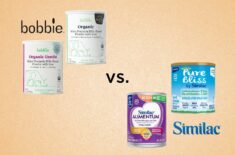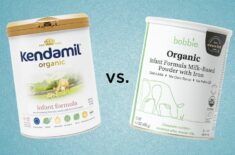Overview
Did you know that iron supports your baby’s ability to learn? (1)
Iron plays a vital role in tissue growth, neurodevelopment, and brain growth. An adequate amount of iron in your growing baby’s body helps support cognitive development. (2)
So, how do you give your baby iron?
Breast milk and iron-fortified infant formula support your baby’s iron needs from infancy up to six months of age.
Starting at seven months old, your baby’s iron requirements increase from 0.27mg to 11mg. This is your baby’s RDA (Recommended Daily Allowance) up to 12 months old. (3)
That’s why your baby’s first foods must include iron-rich foods like chicken.
Here’s another fun fact:
Did you know that introducing meat like chicken as a complementary food for exclusively breastfed infants results in improved zinc absorption? (4)
Like iron, zinc is also an essential nutrient your baby’s body needs to grow and develop properly. (5)
In this article, we’ll discuss ways to safely introduce chicken in baby-led weaning and talk about chicken’s nutrition facts and health benefits. We’ll also discuss preparation, cooking, and storage tips, healthy options, and baby-friendly recipes.
What’s BLW?
BLW (baby-led weaning) is a self-feeding approach where you follow your baby’s lead during shared family mealtimes, according to Dr. Gill Rapley, BLW pioneer. (6)
Eating solids is one of the biggest milestones in a baby’s first year of life, so it’s important to know the dos and don’ts in BLW before taking this feeding approach.
When Can Babies Eat Chicken?
When babies start eating solids at about six months old, meats like chicken are a nutritious option as they provide nutrients essential for babies’ growth and development. (1)
Health Benefits & Top Reasons To Serve
Chicken is a great source of iron, a mineral that helps red blood cells carry oxygen through the body, supports blood volume expansion, brain development, and builds a strong immune system. (2)
Iron comes in two types: heme and non-heme iron.
Heme iron is easier to absorb (14% to 18% absorption rate) and is commonly found in meat and animal products like: (3)
- Poultry (chicken, turkey)
- Red meat (beef, pork, goat, lamb, venison)
- Seafood (tuna, mackerel, haddock, sardines)
- Eggs
Non-heme iron has only a 5% to 12% absorption rate and can be found in plants and iron-fortified products like:
- Iron-fortified infant cereals, wheat, flours
- Tofu
- Beans and lentils
- Dark green leafy veggies (spinach, kale)
To help your baby get more iron from non-heme iron food sources, serve iron-rich foods like chicken together with foods high in vitamin C like:
- Citrus fruits
- Berries (blueberries, raspberries)
- Tomatoes
- Sweet potatoes
- Broccoli
- Cabbage
Note: Some babies may need more iron than others. Talk to your baby’s pediatrician about iron. (1)
Other Nutrition Facts
100 grams of raw, ground chicken contains: (7)
- Energy: 143 kcal
- Fat: 8.1g (10% of the Daily Value)
- Protein: 17g (34% of the DV)
- Iron: 0.8g (4% of the DV)
- Potassium: 522mg (11% of the DV)
- Niacin (Vitamin B3): 5.75mg (35% of the DV)
- Vitamin B6: 0.5mg (39% of the DV)
- Phosphorus: 178mg (25% of the DV)
- Zinc: 1.47mg (13% of the DV)
Especially for infants, protein intake from chicken and other meats has a vital role in their growth and development. (8)
Chicken is also a good source of B-vitamins like Niacin (Vitamin B3) and Vitamin B6. Vitamin B3 converts food into energy and is important for cell development. (9)
Vitamin B6, on the other hand, plays an essential role in brain development, metabolism, and the immune system. (10)
Potassium is vital for proper kidney, heart, muscle, and nerve functions. At the same time, phosphorus supports healthy bones, teeth, and better energy production. (11)(12)
Organic & Pasture-Raised Chicken Vs. Conventional Chicken
Organic Chicken
When preparing homemade food, especially for your baby, we recommend using certified organic chicken. This means that it has the USDA (U.S. Department of Agriculture) organic seal.
Poultry meats and eggs with the USDA organic seal are raised and harvested following these principles:
- Animals must eat only organically-grown feed without animal byproducts and can’t be treated with antibiotics or synthetic hormones.
- Animals must be allowed to roam freely outdoors.
- Animals must not be cloned. (13)
Pasture-Raised Chicken
Pasture-raised chickens are also a good option because they are free to roam outdoors, and their diet consists of bugs, grubs, and grains.
Pasture-raised chicken meat is often higher in iron, Omega 3, antioxidants, and lower Omega 6:3 ratio. (14)
Lower Omega 6:3 ratio means reduced risk of numerous chronic diseases. (15)
Conventional Chicken
Conventional or Industrial-raised chickens, on the other hand, are often enclosed with thousands of other chickens, and their diet consists of genetically-modified soybeans and corn. They are also treated with antibiotics and growth hormones. (16)
These can cause side effects and contribute to antibiotic resistance. Like humans, animals have bacteria in their gut, including antibiotic-resistant bacteria. These organisms have been identified in poultry like chicken and turkey and poultry products worldwide. (17)
Antibiotic resistance happens when germs or bacteria survive after being exposed to antibiotics designed to kill them. If the bacteria that caused food poisoning in humans are antibiotic-resistant, some antibiotics may not treat the illness. This can lead to more costly treatments for people with severe infections. (18)
Because your baby’s growing body is highly susceptible to infections and diseases, it’s best to keep them away from harmful chemicals and substances.
Food Safety FAQs
Is Chicken A Choking Hazard?
Large pieces of chicken meat are high choking risk, so make sure to cut chicken meat according to your baby’s age. See our age-appropriate guidelines when serving chicken below. (19)
Is Chicken An Allergen?
Chicken allergy is most commonly associated with an allergy to feathers and eggs. True chicken meat allergy is rare, and symptoms include stomach cramps, hives, and chest tightness. (20)
As you would when introducing new foods, start by serving a small amount of chicken on its own. If there are no allergic reactions, you can gradually increase the quantity over future servings.
Can My 6 Month Old Have Shredded Chicken?
Yes. Shredding cooked chicken meat is one of the best ways to serve chicken as finger food for babies.
Can Babies Eat Cold Cooked Chicken?
You can easily reheat cooked chicken on the stove by adding enough water to cover the bottom of a skillet. Simmer over medium heat, then use a food thermometer to ensure the meat is cooked at 165°F as recommended by the USDA. (21)
When Can Babies Eat Chicken Nuggets?
Commercial chicken nuggets are highly processed, usually contain inflammatory fats, and are high in sodium. We recommend making a healthy version of chicken nuggets at home using organic spices and safer flours like chickpea flour or almond meal. You can also air fry them or bake them in the oven.
Food Safety Risk With Chicken
Chicken is a nutritious option when your little one is starting solids. However, raw chicken is often contaminated with foodborne bacteria like Campylobacter, Salmonella, and Clostridium perfringens.
CDC (Centers for Disease Control and Prevention) reported an estimated 1 million people getting sick from eating contaminated poultry every year. (22)
The good news, mama, is that there are ways to prevent food poisoning from chicken which include:
- Having a food thermometer to ensure that chicken meat is thoroughly cooked to an internal temperature of 165°F.
- Keeping raw chicken and its juices away from ready-to-eat foods.
- Being mindful when washing raw chicken as chicken juices can contaminate other foods, countertops, and utensils.
- Washing hands before and after handling raw chicken.
Chicken Trivia: It’s OK To Refreeze Defrosted Chicken.
That’s right! According to the USDA, it’s safe to refreeze thawed chicken, but only if it was defrosted below 5°C or in the fridge and not sitting on the countertop. (23)
How Do You Prepare Chicken In Baby Led Weaning?
How Do I Give Chicken To My 6 Month Old?
Give your baby a whole drumstick to munch on. Make sure to remove the skin, loose cartilage, and fat. Drumsticks are easy for babies to grab, enabling good oral-motor skills practice.
How Do You Cut A Chicken Breast For 6 Month Old?
Cut chicken breast into strips about the size of two adult fingers pressed together before serving it to your baby.
How Can I Give Chicken To My 7 Month Old?
At seven months old, you can continue serving drumsticks to your baby and slicing chicken breast in smaller one-inch thick strips.
How To Prepare Chicken For 9 Months Old?
Most babies can bite and tear food at this age, so you can start serving thinner strips of chicken breast–about the size of one adult finger.
How To Prepare Chicken For 12+ Months Old?
Slice cooked chicken meat into bite-sized pieces and serve as finger food or let your little one practice with a pre-loaded fork or spoon.
5 Ways To Prepare Chicken For Baby Led Weaning
- Chicken stock or chicken bone broth. Protein-packed chicken stocks are easy to make from long-simmered chicken bones and feet. Add chicken stock in other baby-led weaning recipes like soups, stews, or braised meats and veggies.
- Puree. Perfect for your baby’s first time eating solids. Cook chicken breast, then cool. Put in a food processor, add ¼ cup of chicken stock, then pureeto soft, baby-friendly consistency.
- Poach Vs. Boiled. Poached chicken is very gently simmered, resulting in moist and tender chicken meat. Boiled chicken is aggressively boiled, which results in dry, rubbery meat.
- Roast. Pre-heat oven to 350ºF, then put chicken rubbed with olive oil and seasoned with oregano or other preferred spices for 45 minutes. Take out, then add veggies like carrots or butternut squash. Roast for another hour, then let cool before slicing and serving to your baby. (Don’t forget to check that chicken meat is 165F or more before serving to your little one.)
- Meatballs. Ground chicken meatballs are good for BLW as ground meats are soft and easy to gnaw with toothless gums. (We’ve got a savory recipe that’s baby, hubby, and kid-approved so keep reading for the details!)
Tip: To decrease prep time, plan ahead and thaw frozen chicken in the fridge the day before cooking chicken. Boneless chicken breasts, bone-in parts, and whole chickens may take 1-2 days or more to safely thaw in the fridge. (23)
What Part Of The Chicken Is Best For Baby Food?
Both dark and white chicken meats are excellent for baby-friendly recipes. Dark meat or the thigh and leg usually have higher fat content, making them juicy and tender.
White meat or chicken breast is also a good option as it can be prepared in multiple ways to allow your child to explore different flavors and textures.
Culinary Combinations With Chicken
Americans eat more chicken than other meat because of its sought-after taste that pairs well with a wide variety of foods, from avocado, butter, coconut, cheese, and yogurt to nuts like almond, cashew, and pistachio.
Chicken also pairs well with nutrient-packed veggies like broccoli, carrot, cauliflower, pumpkin, and sweet potato, and leafy greens like spinach, kale, and bok choy.
You can also mix chicken with pasta, other meats, and fruits like apple, pineapple, pomegranate, and pear. Or season chicken with lemon, garlic, and herbs like thyme, saffron, achiote, and lemongrass to add layers of flavor.
How Often And How Much Solid Food Should I Feed My Baby?
- 6 Months Old: Start with 1-2 tablespoons, 1-2 times a day, as a complement to breast milk or formula.
- 7-8 Months Old: 2-3 tablespoons, two times a day, as a complement to breast milk or formula.
- 9-12 Months Old: 2-4 tablespoons, two times a day, as a complement to breast milk or formula. Gradually increase according to your child’s age. (24)
How To Choose, Handle, And Store Chicken
Here are the guidelines released by the USDA: (23)
Choosing Raw Chicken
- Chicken should feel cold to the touch because chicken is kept cold to prevent bacteria growth and increase its shelf life.
- Skin color should vary from cream-colored to yellow due to the feed given to them. This is not a basis of nutritional value.
- Check for the expiration date.
Proper Handling of Raw Chicken
- Don’t wash raw poultry before cooking because the bacteria in raw meat can cross-contaminate other foods, utensils, and surfaces.
- Place chicken in the fridge at 40°F or below, then cook within 1- 2 days, or freeze at 0 °F.
- Frozen chicken can be thawed in the fridge or cold water placed in a leak-proof bag.
Storing Raw Chicken
- You can freeze chicken in its original packaging or repackage it.
- If freezing for two months or longer, put chicken in an airtight container or overwrap with heavy-duty foil or freezer paper.
- If kept frozen continuously, chicken can last for up to a year.
When purchasing ready-prepared chicken, eat or refrigerate it within two hours. If it’s still hot, cut it into smaller pieces before putting it in the fridge, then consume within 3-4 days. Frozen ready-prepared chicken is best consumed within four months.
An Easy Baby Food Recipe With Chicken
This gluten-free baby and toddler recipe idea can also be enjoyed by the entire family.
Chicken, Blueberry, & Spinach Meatballs
Ingredients
- 1 lb ground chicken meat
- 1 teaspoon ground cumin
- 1/2 teaspoon ground black pepper
- 2 cups cooked spinach
- 1 cup smashed blueberries
- 1/2 cup of cooked chopped onion (optional)
- 1 egg
Procedure
- In a bowl, mix the ground chicken with the egg and the rest of the spices.
- In a separate pan, sautee and thoroughly cook the spinach and blueberries in olive, coconut, or avocado oil.
- Add the cooked spinach and mix well into the meat, eggs, and spices.
- Use teaspoons to form mini meatballs that’ll fit into your baby’s little hands.
- Place the meatballs on top of wax paper on a baking tray.
- Bake at 350 F for 30 minutes or until cooked through.
- Test by inserting a toothpick in the center–if it comes out clean, your meatballs are ready.
Helpful BLW Tools For Mealtimes
REFERENCES
(1) https://www.cdc.gov/nutrition/infantandtoddlernutrition/vitamins-minerals/iron.html
(2) https://www.ncbi.nlm.nih.gov/pmc/articles/PMC6631790/
(3) https://ods.od.nih.gov/factsheets/Iron-HealthProfessional/#h2
(4) https://pubmed.ncbi.nlm.nih.gov/16456417/
(5) https://ods.od.nih.gov/factsheets/Zinc-Consumer/
(6) http://rapleyweaning.com/assets/Defining_BLW_v2.pdf
(7) https://www.nutritionvalue.org/Chicken%2C_raw%2C_ground_nutritional_value.html?size=100+g
(8) https://medlineplus.gov/ency/article/002467.htm
(9) https://ods.od.nih.gov/factsheets/Niacin-Consumer/
(10) https://ods.od.nih.gov/factsheets/VitaminB6-Consumer/
(11) https://ods.od.nih.gov/factsheets/Potassium-Consumer/
(12) https://ods.od.nih.gov/factsheets/Phosphorus-Consumer/
(13) https://www.ams.usda.gov/sites/default/files/media/Organic%20Poultry%20Production%20for%20Meat%20and%20Eggs_FINAL.pdf
(14) https://apppa.org/The-Nutrition-of-Pasture-Raised-Chicken-and-Meats
(15) https://pubmed.ncbi.nlm.nih.gov/12442909/
(16) https://www.piedmont.org/living-better/the-difference-between-pastured-and-industrial-chicken
(17) https://www.cdc.gov/drugresistance/livestock-poultry-producers.html
(18) https://www.cdc.gov/foodsafety/challenges/antibiotic-resistance.html
(19) https://www.cdc.gov/nutrition/infantandtoddlernutrition/foods-and-drinks/choking-hazards.html
(20) https://pubmed.ncbi.nlm.nih.gov/16933414/
(21) https://www.usda.gov/media/blog/2011/05/25/cooking-meat-check-new-recommended-temperatures
(22) https://www.cdc.gov/foodsafety/chicken.html
(23) https://www.fsis.usda.gov/food-safety/safe-food-handling-and-preparation/poultry/chicken-farm-table
(24) https://www.stanfordchildrens.org/en/topic/default?id=feeding-guide-for-the-first-year-90-P02209












